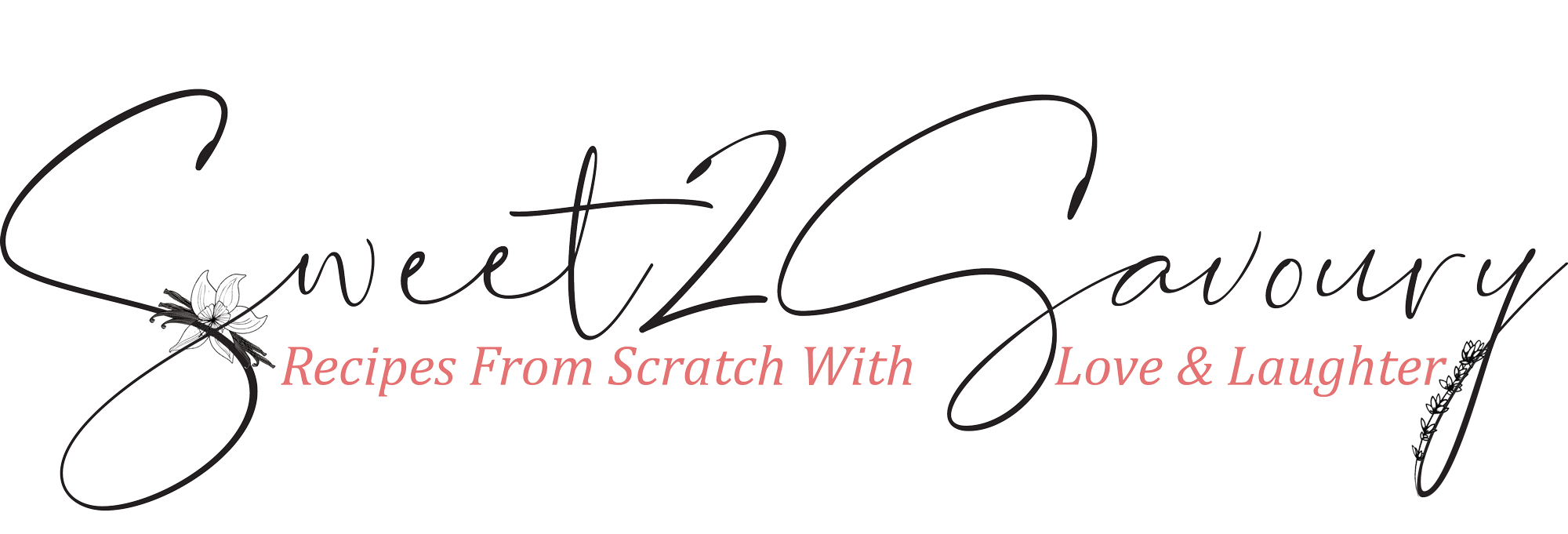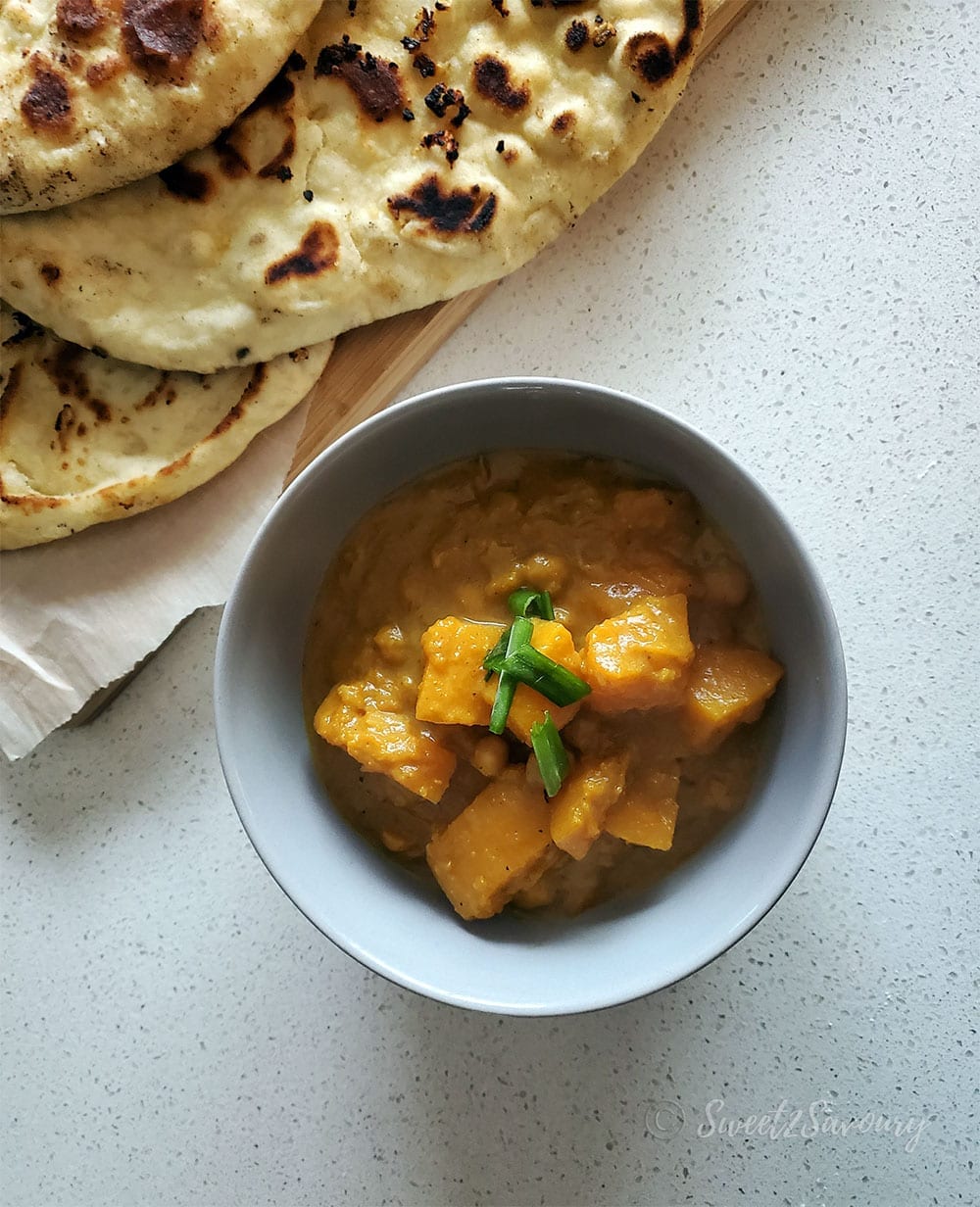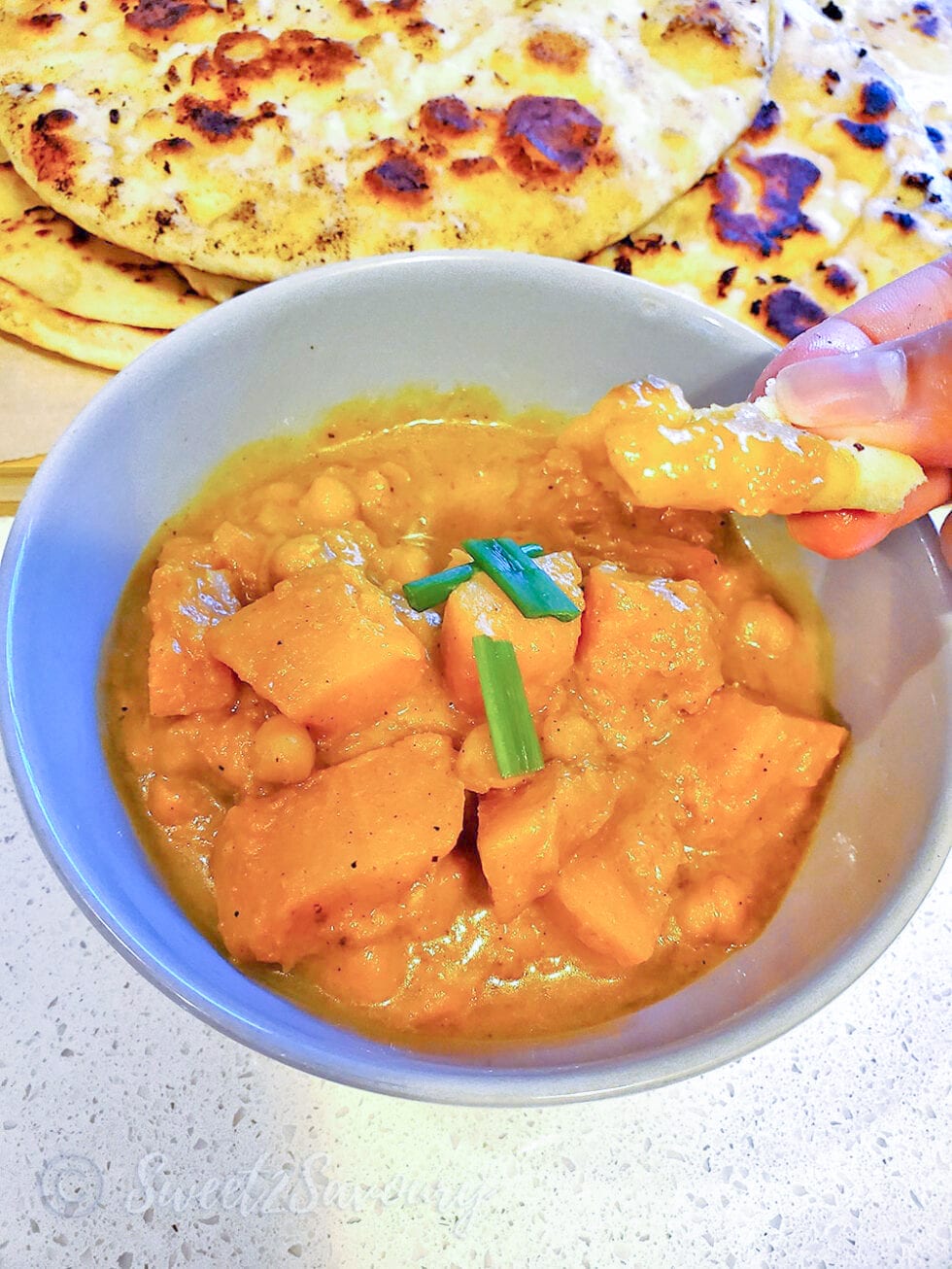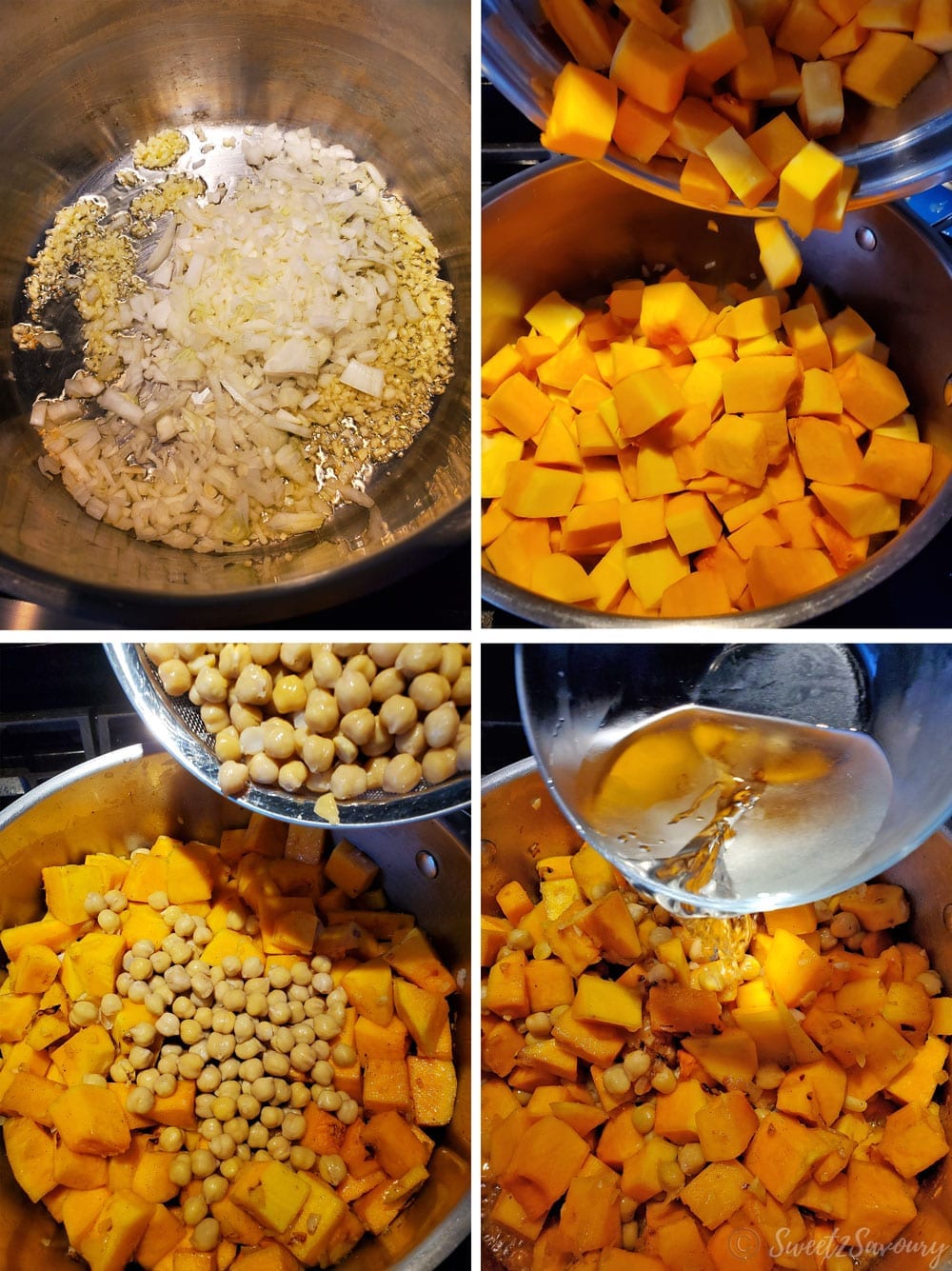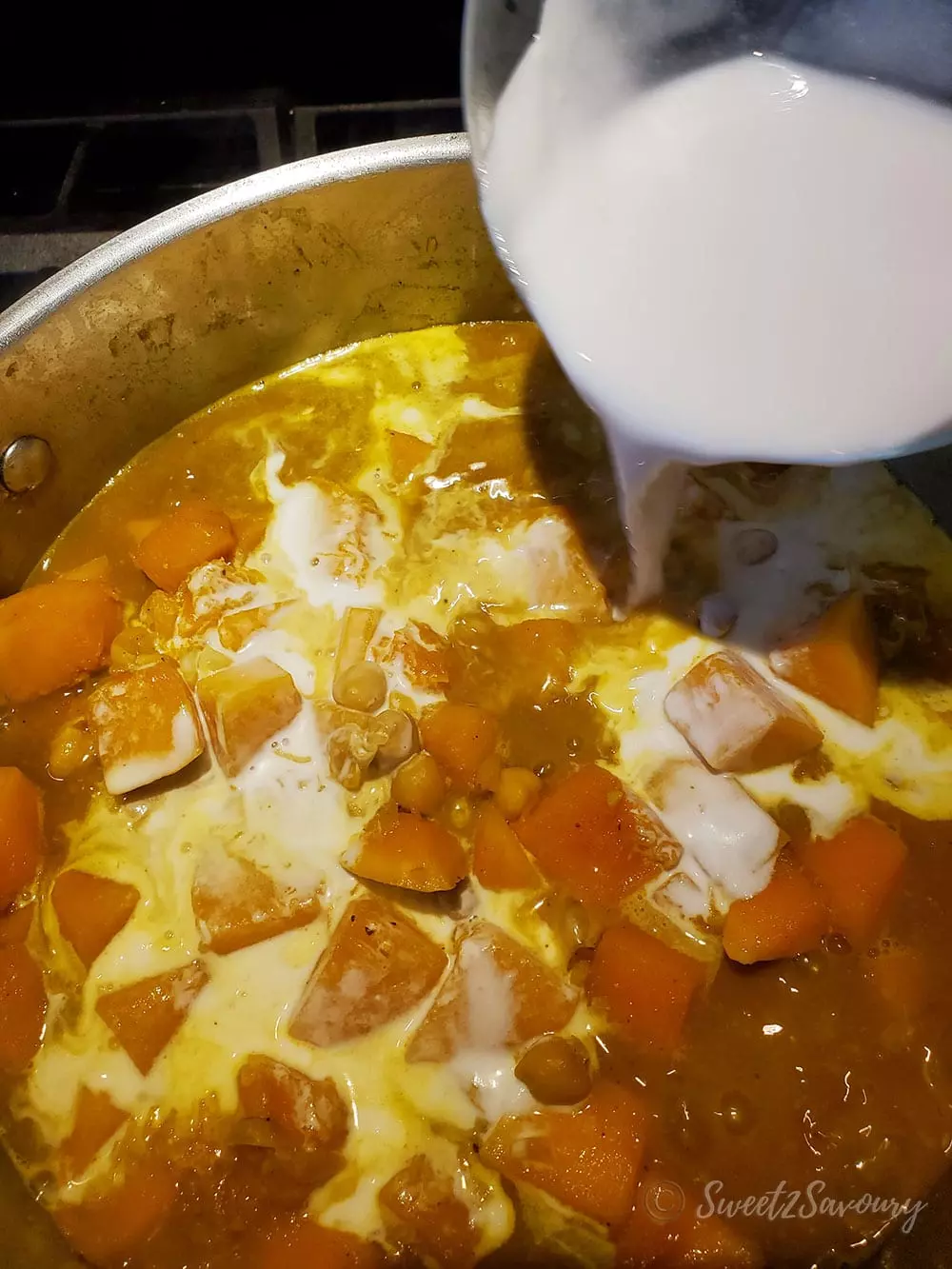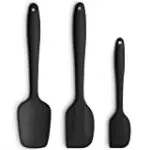608 Hearty and full of flavour! This vegan friendly coconut curry is delicious on its own or even better paired with soft homemade pan fried garlic naan bread. Butternut squash. Such a versatile fruit. That’s right! Fruit! Who knew?! It’s considered a fruit because it grows on a vine. Having said that, no one consumes it like fruit and mainly cooks it like a vegetable. The nutty and sweet flavour of this winter squash is sort of like the sister to a pumpkin. I decided to make this dish because it is different than the usual soup or side dish you’d normally make with squash. (plus, we’re dabbling with the idea of incorporating more vegan / vegetarian dishes in our household. Keyword: dabbling). Using the coconut milk made it more creamy and flavourful. Pair it with my homemade naan and wowie! You’ve got yourself a wholesame meal! Print Pin Rate  Get Recipe Ingredients
Get Recipe Ingredients
*Good To Know*
- How to peel uncooked butternut squash?
Uncooked butternut squash is tougher to cut through due to its raw state (but not impossible!). Some prefer to bake then peel it (which is totally fine), however for our curry, we’ll need to do this prior to cooking. We want to cook our curry with uncooked squash due to the amount of liquid we’re adding to soften it and also because we want our squash to retain some solid texture. If we start with already cooked squash, it will end up turning into soup.
Start by cutting off the top (stem) and bottom part using a cleaver or very sharp knife (the flat ends will help keep the squash upright at times). Place the squash on the cutting board vertically then use a vegetable peeler and start from the middle of the squash to peel the skin with downward strokes OR place squash on its side, length wise and peel with sideways strokes, away from you. Do this until half of the squash has been peeled. Flip the squash around and repeat the same peeling process until the entire squash is peeled. Cut the squash in half, length wise and use a soup spoon or paring knife to scrape out the seeds from the squash. Cut squash into approximately 1 x 1 inch cubes.
An alternative to this can be ready-to-cook peeled & cubed butternut squash you can buy at most grocery stores now. - Why add white wine?
This is optional. Adding wine such as chardonnay (or other white wine with fruity ripe notes ) enhances the flavour and aroma of our curry. If you want to keep this dish kid-friendly then you can totally skip the wine. - Can I use yoghurt instead of coconut milk?
Absolutely! I stuck with coconut milk to make our curry vegan friendly but you can substitute for 1 cup plain, regular or greek yoghurt for sure (or even regular milk).
Before you begin, see my notes on peeling and cutting the butternut squash above. It’s easier to use uncooked butternut squash because you can control its consistency during the cooking process. I mean, who wants to end up with baby food type of squash?! Unless that’s your preference… hey… no one’s judging here! Hmm… that gives me an idea to create future posts on baby food! The key is to cut your squash into even size cubes so that we don’t end up with uneven cooked squash.
With just a few ingredients, you’ll be able to turn this dish into a hearty meal. I only used curry powder to keep it simple, however, if you have garam masala, add 1 to 2 teaspoons to enhance your curry with this spice blend.
When it comes to cooking, the order in which you add your ingredients plays a role in how it’s being sauteéd or seared and how the flavours are developing in layers. For example, adding garlic and onions as the first layer releases a beautiful aroma. Layering the butternut squash into the garlic/onions with the help of salt, helps brown the squash by drawing out the juice. Once the chickpeas and curry powder have been mixed in, the heat continues to marry these flavours together and with a dash of wine the aroma intensifies and flavour is enhanced. When following a recipe, I recommend to follow it to a tee as there is a reason as to why you are adding the ingredients in that order.
Adding the coconut milk near the end will help avoid the curry from curdling (along with consistent stirring and retaining medium low to low heat). The reason we add the coconut milk last is because we don’t want the oils and proteins in the milk to separate. The end result is truly lip-smacking delicious and you wouldn’t even care that this is vegan!
Butternut Squash Chickpea Coconut Curry
Hearty and full of flavour! This vegan friendly butternut squash chickpea coconut curry is delicious on its own or even better paired with soft homemade garlic pan fried naan bread.
5 from 1 vote
Prep Time: 10 minutes minutes
Cook Time: 40 minutes minutes
Total Time: 50 minutes minutes
Yields: 4
Ingredients
- 2 tablespoons olive oil
- 1 cup yellow onions, diced
- 1 tablespoon garlic, minced
- 1 medium butternut squash, peeled, de-seeded & cubed
- 3 teaspoons sea salt
- 1 tsp ground black pepper
- 1 can chickpea, drained
- 1 cup white wine (chardonnay), (optional)
- 3 tablespoons curry powder
- 3½ cups vegetable stock
- 1 cup coconut milk
Garnish
- 1 tablespoon green onions, chopped
COOK MODE – Prevent your screen from going dark
INSTRUCTIONS
- In a large soup or stock pot, heat olive oil on high heat. Add yellow onions and sauteé for 1 minute. Add garlic and continue sauteéing until fragrant and onions are translucent.
- Add butternut squash, sea salt and black pepper. Mix for 2 minutes on high heat. Add chickpeas and continue mixing for 1 minute.
- Pour white wine over squash and keep stirring for another 3 minutes or until the wine has evaporated a little bit. (skip this step if you're not using wine)
- Sprinkle curry powder onto squash and stir continuously on high heat for 1 minute. Add vegetable stock and bring to boil. Cover pot with lid and turn heat down to medium low. Cook for 20 minutes stirring occasionally.
- Remove pot lid and cook curry uncovered for another 20 minutes to allow some of the liquid to evaporate and thicken curry. Pour coconut milk into curry, mix and continue to cook for another 5 minutes.
- Garnish with chopped green onion and serve with Naan bread or rice.
Category: Main Course
Diet: Vegetarian
Keyword: chickpea, coconut, curry, naan, squash
Tips
How to peel uncooked butternut squash?
Uncooked butternut squash is tougher to cut through due to its raw state (but not impossible!). Some prefer to bake then peel it (which is totally fine), however for our curry, we’ll need to do this prior to cooking. We want to cook our curry with uncooked squash due to the amount of liquid we’re adding to soften it and also because we want our squash to retain some solid texture. If we start with already cooked squash, it will end up turning into soup. Start by cutting off the top (stem) and bottom part using a cleaver or very sharp knife (the flat ends will help keep the squash upright at times). Place the squash on the cutting board vertically then use a vegetable peeler and start from the middle of the squash to peel the skin with downward strokes OR place squash on its side, length wise and peel with sideways strokes, away from you. Do this until half of the squash has been peeled. Flip the squash around and repeat the same peeling process until the entire squash is peeled. Cut the squash in half, length wise and use a soup spoon or paring knife to scrape out the seeds from the squash. Cut squash into approximately 1 x 1 inch cubes.
An alternative to this can be ready-to-cook peeled & cubed butternut squash you can buy at most grocery stores now.
Why add white wine?
This is optional. Adding wine such as chardonnay (or other white wine with fruity ripe notes ) enhances the flavour and aroma of our curry. If you want to keep this dish kid-friendly then you can totally skip the wine.
Can I use yoghurt instead of coconut milk?
Absolutely! I stuck with coconut milk to make our curry vegan friendly but you can substitute for 1 cup plain, regular or greek yoghurt for sure (or even regular milk).
Uncooked butternut squash is tougher to cut through due to its raw state (but not impossible!). Some prefer to bake then peel it (which is totally fine), however for our curry, we’ll need to do this prior to cooking. We want to cook our curry with uncooked squash due to the amount of liquid we’re adding to soften it and also because we want our squash to retain some solid texture. If we start with already cooked squash, it will end up turning into soup. Start by cutting off the top (stem) and bottom part using a cleaver or very sharp knife (the flat ends will help keep the squash upright at times). Place the squash on the cutting board vertically then use a vegetable peeler and start from the middle of the squash to peel the skin with downward strokes OR place squash on its side, length wise and peel with sideways strokes, away from you. Do this until half of the squash has been peeled. Flip the squash around and repeat the same peeling process until the entire squash is peeled. Cut the squash in half, length wise and use a soup spoon or paring knife to scrape out the seeds from the squash. Cut squash into approximately 1 x 1 inch cubes.
An alternative to this can be ready-to-cook peeled & cubed butternut squash you can buy at most grocery stores now.
Why add white wine?
This is optional. Adding wine such as chardonnay (or other white wine with fruity ripe notes ) enhances the flavour and aroma of our curry. If you want to keep this dish kid-friendly then you can totally skip the wine.
Can I use yoghurt instead of coconut milk?
Absolutely! I stuck with coconut milk to make our curry vegan friendly but you can substitute for 1 cup plain, regular or greek yoghurt for sure (or even regular milk).
Your Own Digital Notes
Nutrition Facts
Butternut Squash Chickpea Coconut Curry
Amount per Serving
Calories
349
% Daily Value*
Fat
20
g
31
%
Saturated Fat
12
g
75
%
Sodium
2589
mg
113
%
Potassium
947
mg
27
%
Carbohydrates
34
g
11
%
Fiber
6
g
25
%
Sugar
8
g
9
%
Protein
4
g
8
%
Vitamin A
20414
IU
408
%
Vitamin C
44
mg
53
%
Calcium
139
mg
14
%
Iron
5
mg
28
%
* Percent Daily Values are based on a 2000 calorie diet.
Did you make this? I would love to see your creation!Tag me @sweet2savoury on Instagram and hashtag it #sweet2savoury
